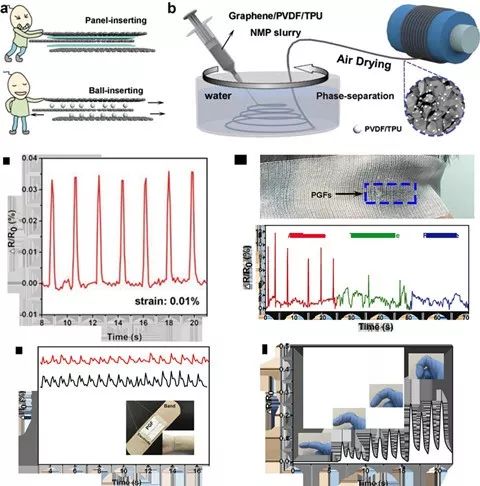Sensors are the core elements of IoT terminal devices. Wearable stress and strain sensors can be used to collect important human signals and human-computer interactions. In addition to the high sensitivity characteristics required for accurate sensing, practical applications have very high requirements for the wearability, weight, reliability and stability of the sensor. Therefore, more sensitive, miniaturized and integrated is the current development trend of sensors. Integrating sensors into traditional fibers and taking advantage of their ability to be woven directly into clothing to accurately capture local deformations of the human body is an important idea for miniaturization and integration of wearable sensor devices. Graphene-polymer composite fiber has the advantages of light weight, low signal noise and low energy consumption, and can be used for resistance strain sensors. For sensing small local deformations of the human body such as beating heart, pulse and blink, the strain is in the range of 0-10%, and the sensor device needs to have a large change in structure and resistance when the deformation occurs, that is, high sensitivity, so as to achieve accurate signal capture and alignment Accurate identification of different action states. However, the sensitivity of graphene-based fiber sensors in the 0-10% strain range is generally low (GF ~ 0.1-50), how to improve the sensitivity of graphene-based fiber sensors in the small strain range is a problem. In order to solve the above problems, the research group of Ding Guqiao, a researcher at the Shanghai Institute of Microsystems and Information Technology, Chinese Academy of Sciences, proposed a strategy to improve the sensitivity by reducing the contact area between graphene and polymer through structural design. They used the phase separation process of graphene / polyvinylidene fluoride / polyurethane DMF system in the aqueous phase to prepare graphene porous network fibers modified by polymer nanospheres. This structure greatly enhanced the graphene sheet when the fiber was deformed. The structural changes between the layers, thereby achieving a significant increase in the sensitivity of graphene-based fibers. The sensitivity factor value is 51 at 0-5% strain and 87 at 5-8% strain. Through weaving integration, they further verified the accuracy of the fiber ’s important signal collection in the human body and the feasibility of analyzing different motion states Sex. At the same time, the minimum deformation detection limit of this new graphene-based fiber sensor reaches 0.01%, and the better strain-resistance linear relationship can ensure the accuracy of signal post-processing. The cycle life of> 6000 times is conducive to the stability of practical applications . This fiber is woven into gauze and used as an eye mask, which can monitor the rotation of the eyeball and other information in real time, and it can be used in the monitoring of people with eye diseases and sleep monitoring in the future; at the same time, the fiber is integrated into the wound patch and attached to the wrist to identify the wrist The pulse, and the pulse signal can clearly show the different signals on the pulse; the fiber can also be knitted into gloves to sense the bending of different hands, indicating that it accurately controls the movement signal. It is precisely because of the existence of the small ball structure that the fiber is given higher sensitivity than ordinary fibers. The above results meet the requirements of wearable strain sensors and reflect the application potential of graphene-based strain sensor devices in the fields of smart medical treatment and wearable devices. . The above work was titled Porous Fibers Composed of Polymer Nanoball Decorated Graphene for Wearable and Highly Sensitive Strain Sensor and was recently published online in the academic journal "Advanced Functional Materials". The first author is Huang Tao, a doctoral student at the Shanghai Microsystems Institute. The authors are Ding Guqiao and He Peng. Ding Guqiao's research group has long been devoted to the basic research on the innovative preparation and application of graphene materials. Related work has been supported by the National Natural Science Foundation of China, youth projects (51802337, 11774368 and 11804353) and the post-doctoral innovative talent support program (BX201700271) and Shanghai. The strong support of the Municipal Science and Technology Commission project (18511110600).
The main function of the edge banding is to seal the cross-section of the board, so as to avoid the damage of the board and the adverse factors (mainly moisture) in the process of use and prevent the formaldehyde inside the board from volatilizing, and at the same time achieve the effect of beautiful decoration.
The product has the following main features: smooth surface, no blistering, no ribbing, moderate gloss, smooth surface and back surface, uniform thickness, uniform width, reasonable hardness, high elasticity, good quality, strong wear resistance, trimmed and sealed The color of the side and the side is close to the surface color, not whitish, good gloss, and the overall color of the finished furniture is coordinated.
PVC Edge Banding For Cabinet,Pvc Edge Banding,Banding For Cabinet,T Shape Pvc Edge Banding For Kitchen Cabinet Henan Shunbang Chemical Industry CO.,Ltd , https://www.pvcresinchemical.com